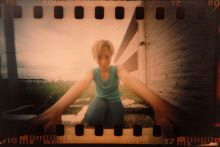Argentina: Homemade Portraits of Life Behind Bars
 Marcela Valente - Inter Press Service Marcela Valente - Inter Press Service
go to original
March 26, 2010


| | Self-portrait (Liliana Cabrera) |  |
Buenos Aires - "I wanted to take a self-portrait, and I thought about keeping a straight face, but it came out all weird, with these very long arms," says Liliana Cabrera about the photo she took with a camera she made herself, out of a condensed milk tin, at a workshop in an Argentine prison.

The pinhole camera workshop is held at Unit 3, a federal women's prison in Ezeiza, on the outskirts of Buenos Aires.

About 15 inmates are taking the course, and there are more than 80 women on the waiting list. The workshop teaches them to make a camera and take and develop photographs.

"This kind of photography is much more of a craft than the conventional sort. It's like going back to first principles," Alejandra Marín, one of the two course coordinators, told IPS. "The first stage is learning the theory, but after that it's a far more creative process. To begin with, these cameras have no viewfinder," she said.

A pinhole camera is simply a light-tight box, without a lens, with a pinhole on one side which lets in light. The pinhole is covered with light-proof tape until the exposure is taken, when it is opened for about a minute. "You have to use some imagination to figure out what the picture is going to look like," Marín said.

The women make their cameras out of small rectangular match boxes, or tins of condensed milk, and use photographic paper. "Very high quality photos can be taken," said Marín.

The photography workshop was first offered in 2007 as part of a range of crafts and trades courses, by Yo No Fui, a non-profit social and cultural organisation headed by María Medrano. "Our aim is to support women inside and outside prison, because we realise that the moment of their release is a crucial time," she told IPS.

"Many of the women have nothing on the outside, no family, no job, no place to go and no one to take them in. And the state's mechanisms for helping them cope when they are released have broken down," she said. In addition, stigma and prejudice make it virtually impossible for them to get a job.

The Yo No Fui organisation provides silkscreen printing, librarianship, knitting, bookbinding, carpentry, poetry and textile design workshops in the prison. Some of these courses are also offered outside, at a centre in the Buenos Aires district of Palermo, for women who have been released or are on short-term prison leave.

"We concentrate on the artistic side of things, because we believe that art is a tool for personal transformation. Even when we are teaching trades to give them job skills, we always aim for a creative, artistic focus," Medrano said.

The photography workshop has been very much in demand ever since it included making handmade cameras. In the first year, the participants worked with donated mass-produced cameras using rolls of film, which they sent to photo laboratories outside the prison to be developed.

Now they learn to do everything themselves, from making the camera to developing the photos. "They tend to take portraits, which don't come out as clearly because the subjects move during the exposure. But photos of fixed objects turn out perfectly with these cameras," Marín said.

In any case, she added, the participants like the results. "They find the pictures are more artistic," she said.

Thirty-six photographs selected from the workshop were shown at a December exhibition at the Ricardo Rojas Cultural Centre in the Argentine capital. Some of them were sold.

"I never thought we'd end up having our photos shown at an exhibition," Cabrera told IPS.

According to Cabrera, a few professional photographers took an interest in their technique and appreciated the images they had taken. "They told us that they looked like they had been taken in different places, but they were all shot in a tiny courtyard measuring only two by three metres," said the 29-year-old, who has spent three years behind bars, and still has prison time to serve.

"In two years' time I'll be eligible for short-term prison leave. It sounds like a long time, but it isn't really. This workshop makes the time pass more quickly. We look forward to it eagerly every week. The coordinators (Marín and her colleague Guadalupe Faraj) listen to us. They don't treat us off-handedly, like inmates, they treat us like individuals," she said. |



